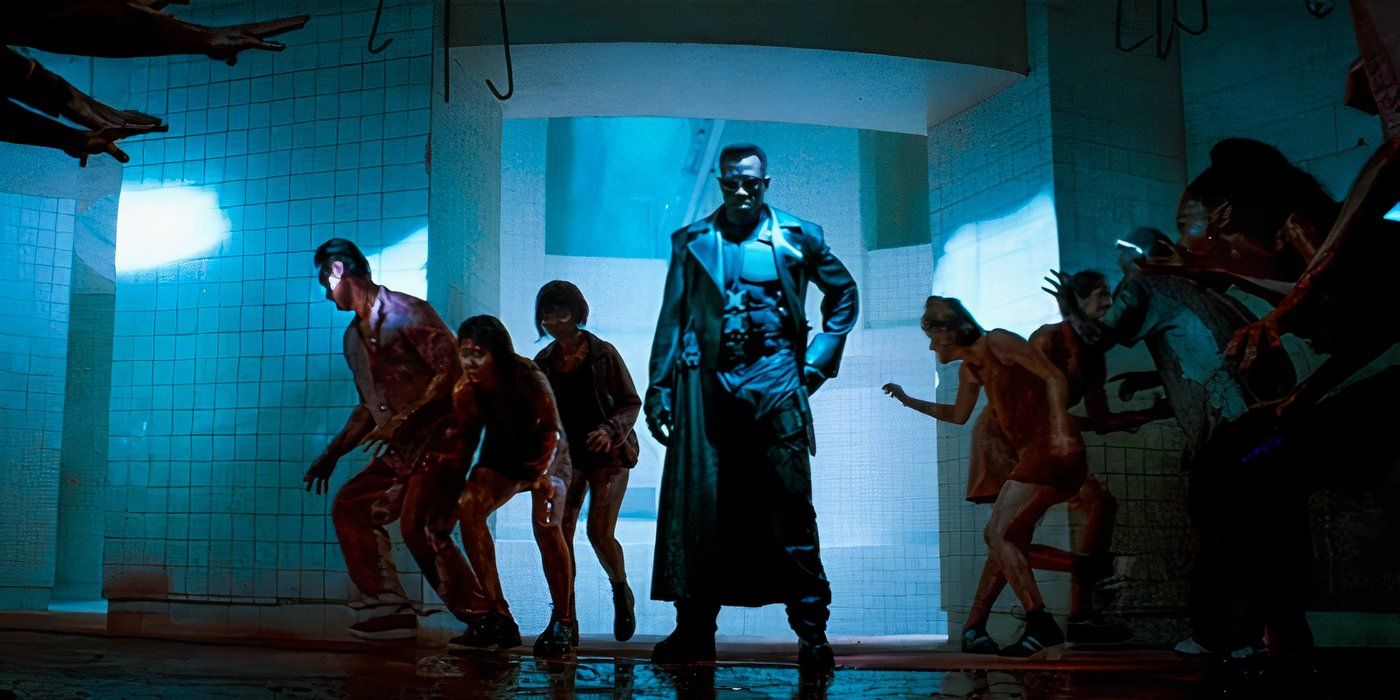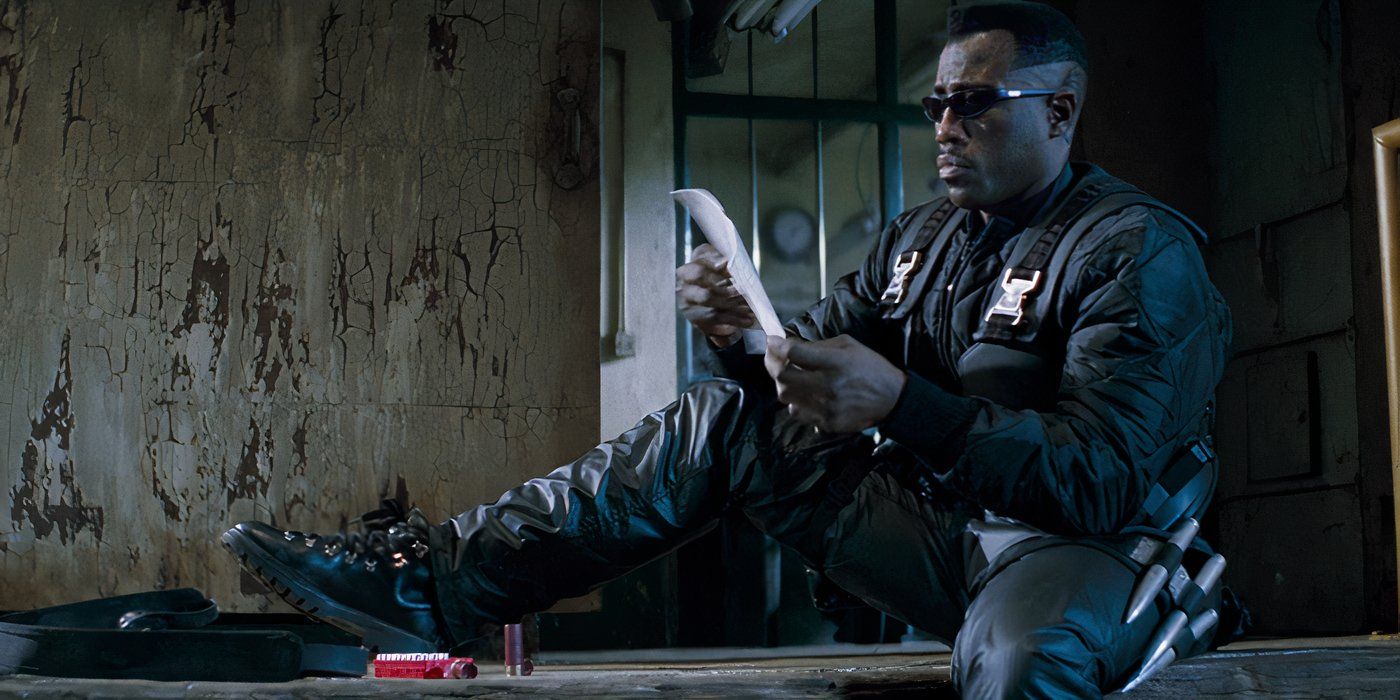For more than a year, Marvel Cinematic Universe fans have been buzzing about the struggling development of Mahershala Ali’s Blade reboot. The question often posed by those scratching their heads is “Why can’t Marvel Studios figure out how to make a movie about a vampire hunter slaying vampires?” What few fans of the MCU know is that three decades ago, Hollywood was struggling with the same question when Wesley Snipes starred in the original Marvel adaptation.
Like many Marvel properties that struggled to reach the silver screen, 1998’s Blade had a chaotic development history. Yet, once the ’90s action star joined the project, along with comic book geek David S. Goyer as screenwriter and a British special effects artist named Stephen Norrington as director, Blade became a surprise hit that broke the barriers for Marvel in Hollywood. Had it not been for these three individuals, there might not have been a Marvel Cinematic Universe today.
‘Blade’ Was Made Due To Marvel Going Bankrupt
Blade was hardly a household name compared to Spider-Man and Captain America. Nicknamed “the Daywalker”, Blade made his Marvel Comics debut in the pages of The Tomb of Dracula #10 (July 1973). Created by Marv Wolfman and Gene Colan, the future vampire hunter entered the world as Eric Brooks. He was born part-vampire as the result of his mother being bitten by vampire supervillain, Deacon Frost. Inheriting genetic enzymes from his mother, Brooks possesses vampire strengths and weaknesses, including slow aging but with immunity from sunlight. He grows into a vampire-hating vigilante under the titular name he earned from other hunters due to his brilliant skills with knives and daggers.
Come the ‘80s, Marvel’s legendary leader Stan Lee was constantly pitching his library of superheroes for the cinemas to any major studio willing to listen. While there were blockbuster hits in the genre with Superman: The Movie, Batman, and Teenage Mutant Ninja Turtles, comic book movies were still not taken seriously due to the lack of innovative VFX resources and limited audience appeal. When Marvel finally had a character reach theaters with Howard the Duck in 1986, its box office failure hindered any chance of future superheroes getting the big screen treatment. Fast-forward to the early ’90s, Marvel filed for bankruptcy, resulting in their characters getting their film rights sold.
Regarding Blade, Marvel found interest from future Batman Begins screenwriter Goyer who pitched the character as a superhero for the growing hip-hop generation while paying homage to the character’s ’70s blaxploitation roots. As Goyer recounted in Entertainment Weekly’s oral history of the movie, he envisioned Blade as a trilogy that served as a metaphor for “racial animosity” in the world.
The Studio Wanted ‘Blade’ To Be a Comedy Starring a White Actor
Taking the project to New Line Cinema in 1992, the studio seemed perfect for Blade due to its success with 1990’s Teenage Mutant Ninja Turtles. They were also the home of the wildly popular, but inexpensive A Nightmare on Elm Street franchise as well as the House Party trilogy. The version of the script that Goyer presented to the studio was deemed too expensive due to its combination of martial arts and horror elements. With little knowledge of Blade, but lots of experience with modestly budgeted genre pictures, the studio felt the project would be better served as an action comedy with a white male lead, according to EW’s oral history. Had this gone through, Blade would have been just another unfaithful Marvel adaptation no different than 1989’s The Punisher and 1990’s Captain America. Goyer, a stickler for staying true to the source material, pushed back on the studio’s ideas.
After winning the conversation on race-swapping Blade, Marvel believed it found the right actor to appeal to the hip-hop crowd when interest came from rapper LL Cool J to play the title role. New Line, however, only considered three commercial-friendly choices for the Daywalker: Denzel Washington, Laurence Fishburne, and Wesley Snipes. All three actors rose to prominence in an era where young black talent began to emerge with grounded but powerful performances in landmark classics such as Do The Right Thing, Boyz in the Hood, and Malcolm X. Of all the actors in contention, Snipes’s physicality put him in the lead as the frontrunner. Ironically, the actor was attached to an early version of Black Panther and only switched over to Blade when the former project stalled in development.
Based on New Line’s past success in horror, the studio considered primarily genre directors for Blade including Ernest Dickerson (Demon Knight), Sam Raimi (The Evil Dead), and David Fincher (Alien 3). Ultimately, the studio settled on the unknown Norrington who made his directing debut with 1994’s Death Machine. His frantic cinematic style along with his balance of action and drama appealed to Snipes and the studio. Rounding out the cast were a set of reliable actors like Stephen Dorff as Deacon Frost, N’Bushe Wright as hematologist Karen Jansen, and the legendary Kris Kristofferson as Blade’s mentor Whistler. With a reported $45 million budget, Blade would prove to be a more serious effort than Marvel’s shoestring-budgeted productions.
‘Blade’ Was Marvel’s First R-Rated Movie
As a comic book movie, Blade broke new ground in some very unprecedented ways. Projects featuring black superheroes such as Robert Townsend’s The Meteor Man and Shaquille O’Neal’s Steel had taken a beating at the box office due to their cartoony, family-friendly direction. Additionally, the adaptation of Todd McFarlane’s incredibly violent antihero Spawn starring Michael Jai White was watered down to a PG-13 rating, which resulted in an unfavorable reception. Though Marvel’s parent company at the time, Toy Biz, was eager to sell Blade action figures to kids, the filmmakers were defiant about producing a hard R-rated superhero movie with little time for tongue-in-cheek humor.
A major part of Blade’s enduring popularity was how the movie subverts horror movies about vampires. The title character was no Van Helsing, and as Snipes recalled in EW’s oral history, he envisioned Blade “like Shaft, but like Kool Moe Dee at the same time.” He took what Marvel Comics had established for the character and brought him to life as a throwback to the samurai heroes depicted in Akira Kurosawa pictures: A master swordsman grounded in the street who speaks few words. Simultaneously, Goyer and Norrington aimed to avoid clichéd vampire tropes. They did not want Frost and his gang of bloodsuckers to be tragic Anne Rice personalities or make them into over-the-top Marvel supervillains. Taking inspiration from The Lost Boys and From Dusk Till Dawn, the vampires in Blade had a Tarantino-esque swagger — both sexy and violent at the same time — as they treated their thirst as a gift rather than a disease.
Initially planned for a late 1997 release, Blade faced one last hurdle to the big screen. The initial test screening of the movie had a 140-minute running time that was poorly received. The largest problem was the climax featuring the Daywalker taking on Frost as a mutating blob of blood. New Line hardly had a Jurassic Park-level budget to work with. Even in those days, CGI was still difficult to sell on screen unless it was under the direction of Steven Spielberg or James Cameron. If Blade fell short at the box office, it would have made studios increasingly resistant to adapting other Marvel properties. New Line opted to delay Blade’s release nearly a year to edit 20 minutes out of the film and reshoot the climax with Snipes and Dorff in a straight-up sword fight. Additionally, the re-edits resulted in the removal of Stan Lee’s cameo as a cop as well as an extended ending that teased the Spider-Man nemesis, Morbius, for the sequel.
‘Blade’ Paved the Way for Marvel on the Big Screen
With changes made, New Line executive Michael De Luca was more than pleased with the finished product. Blade was released in August 1998 and the studio capitalized on the hype by hosting vampire parties across the United States. Despite mixed reviews from critics, casual audiences and Marvel fans turned out for the famed comic book company’s first true blockbuster. By the end of its run, Blade turned in $131 million worldwide. Marvel, however, only received $25,000 as a flat fee. But this was only the beginning of something much bigger for them.
As Snipes reprised Blade for the franchise’s next two installments, in 2002 and 2004, Marvel’s rise to box office dominance hit significant benchmarks with 2000’s X-Men and 2002’s Spider-Man. Though these blockbusters paved the way for Marvel Studios’s formation, Blade’s contribution to Marvel on the big screen cannot be overlooked. Fans continue to cosplay as Snipes’ version of the Daywalker at comic conventions and horror expos. While the future of Ali’s Blade in the MCU remains in question, Snipes’ critically acclaimed cameo as the character in Deadpool & Wolverine was proof that not only do fans still have love for his Daywalker, but they also value his important contribution to the Marvel Universe that audiences pack the theaters to see today.
Blade is currently available to rent or buy on Prime Video in the U.S.
WATCH ON PRIME VIDEO






